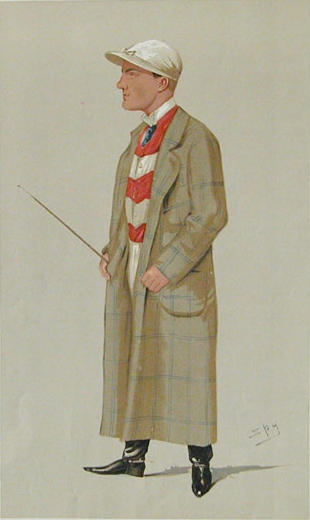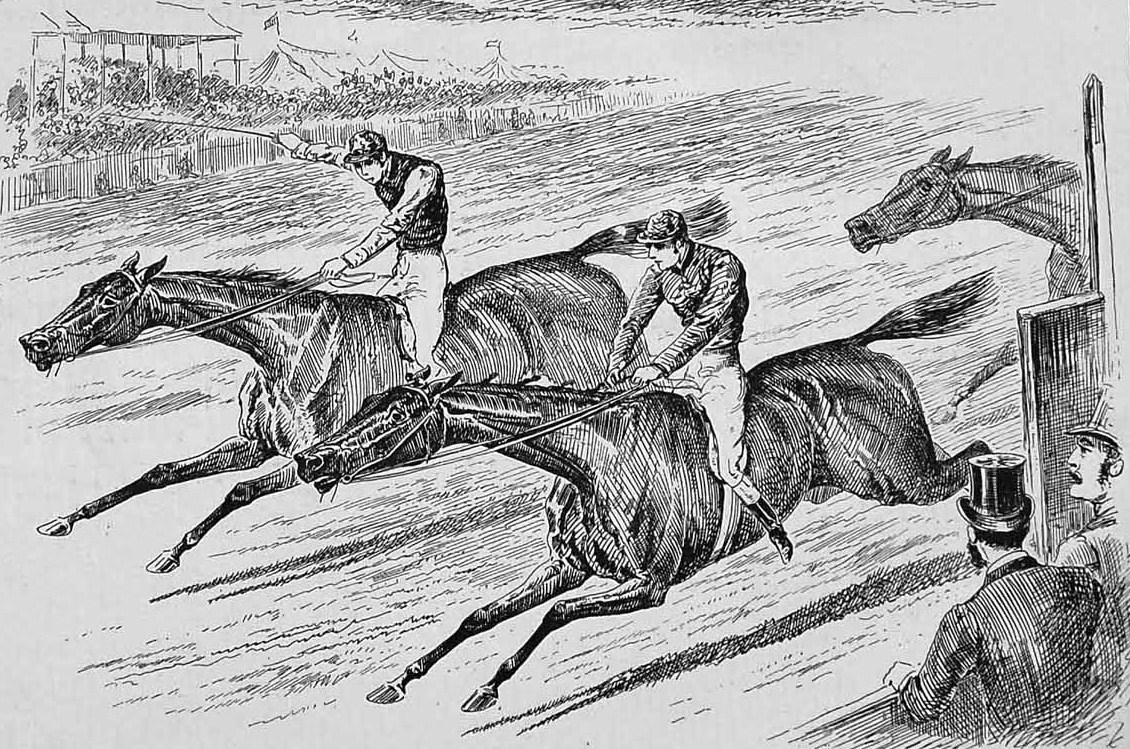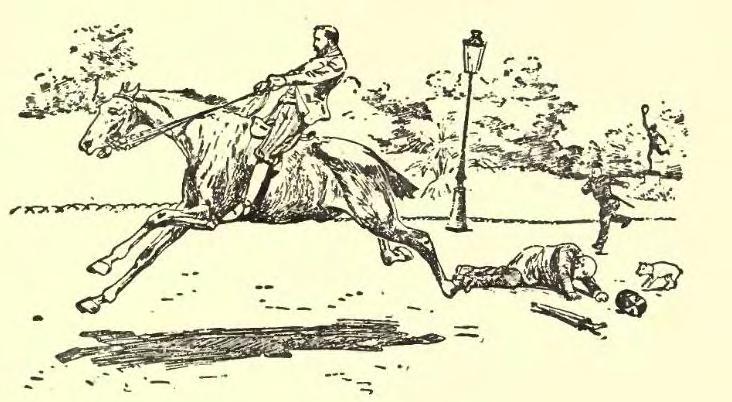|
Throstle (horse)
Throstle (1891–1910) was a British Thoroughbred racehorse and broodmare. Born partially blind and considered a likely candidate for euthanasia as a foal she nevertheless proved herself one of the two best fillies of her generation in Britain. She showed considerable promise despite failing to win in three starts as a juvenile in 1893 and began her second season by running sixth to Amiable in the 1000 Guineas. In the summer of her second season she made rapid progress, winning the Coronation Stakes and Nassau Stakes as well as finishing fourth against very strong male opposition in the Eclipse Stakes. Poor form in training led to her starting at odds of 50/1 for the St Leger but she created a huge upset by defeating the Epsom Derby winner Ladas. She failed to win again and was retired from racing in 1895. She had little success as a dam of winners. Background Throstle was a bay mare bred in England by Lord Alington who owned her in partnership with Sir Frederick Johnston ... [...More Info...] [...Related Items...] OR: [Wikipedia] [Google] [Baidu] |
Petrarch (horse)
Petrarch (foaled 1873), was a British Thoroughbred racehorse and sire who won two British Classic Races in 1876. In a career that lasted from October 1875 to October 1878 he ran sixteen times and won eight races. In 1875, Petrarch won the Middle Park Stakes on his only appearance of the season. As a three-year-old in 1876 he won two of the three races which comprise the Triple Crown, taking the 2000 Guineas at Newmarket and the St Leger at Doncaster. He finished unplaced when favourite for The Derby. As a four-year-old he won three races including the two and a half mile Ascot Gold Cup which at that time was regarded as the most important weight-for-age race in the world. Petrarch was regarded by contemporary experts as a brilliant, but inconsistent performer. After winning once as a five-year-old in 1878 he was retired to stud where he became a successful sire of winners. Background Petrarch was an exceptionally good-looking bay horse bred by J. E. Gosden at Midhurst in West ... [...More Info...] [...Related Items...] OR: [Wikipedia] [Google] [Baidu] |
Epsom Derby
The Derby Stakes, also known as the Epsom Derby or the Derby, and as the Cazoo Derby for sponsorship reasons, is a Group 1 flat horse race in England open to three-year-old colts and fillies. It is run at Epsom Downs Racecourse in Surrey on the first Saturday of June each year, over a distance of one mile, four furlongs and 6 yards (2,420 metres). It was first run in 1780. It is Britain's richest flat horse race, and the most prestigious of the five Classics. It is sometimes referred to as the "Blue Riband" of the turf. The race serves as the middle leg of the historically significant Triple Crown of British horse racing, preceded by the 2000 Guineas and followed by the St Leger, although the feat of winning all three is rarely attempted in the modern era due to changing priorities in racing and breeding, and the demands it places on horses. The name "Derby" (deriving from the sponsorship of the Earl of Derby) has been borrowed many times, notably by the Kentucky D ... [...More Info...] [...Related Items...] OR: [Wikipedia] [Google] [Baidu] |
Newmarket Racecourse
Newmarket Racecourse is a British Thoroughbred horse racing venue in Newmarket, Suffolk, Newmarket, Suffolk, comprising two individual racecourses: the Rowley Mile and the July Course. Newmarket is often referred to as the headquarters of Horse racing in the United Kingdom, British horseracing and is home to the largest cluster of training yards in the country and many key horse racing organisations, including Tattersalls, the National Horseracing Museum and the National Stud. Newmarket hosts two of the country's five British Classic Races, Classic Races – the 1,000 Guineas and 2,000 Guineas, and numerous other Group races. In total, it hosts 9 of British racing's List of British flat horse races#Group 1, 36 annual Group One, Group 1 races. History Racing in Newmarket was recorded in the time of James VI and I, James I. The racecourse itself was founded in 1636. Around 1665, Charles II of England, Charles II inaugurated the Newmarket Town Plate and in 1671 became the fi ... [...More Info...] [...Related Items...] OR: [Wikipedia] [Google] [Baidu] |
Witch Elm
Witch Elm (1904–1923) was a Thoroughbred racehorse owned by the William Hall Walker and trained by Jack Robinson. She was a daughter of Orme, who won the Eclipse Stakes twice and her dam was Cannie Lass, who was a daughter of Ayrshire. Racing career She won five races out of the nine she contested as a two-year-old, including the Cheveley Park Stakes and the West of Scotland Foal Stakes at Ayr. Amongst her other races were a fifth place in the National Breeders' Produce Stakes at Sandown and a third place in the Lancashire Breeders' Produce Stakes at Liverpool. As a three-year-old she easily won the 1000 Guineas from Fragility after starting the 4/1 favourite, but could not repeat this classic winning form over longer distances. Breeding career Witch Elm did not produce any top racehorses, but some of her descendants became classic winners in Brazil. In 1919 Witch Elm produced the filly Lady Clarence, who was sired by Queen Alexandra Stakes winner Royal Realm. Witch Elm ... [...More Info...] [...Related Items...] OR: [Wikipedia] [Google] [Baidu] |
Love In Idleness (horse)
Love in Idleness (1918 – 1939) was a British Thoroughbred racehorse and broodmare. Her diminutive stature and courageous racing style made her one of the most popular horses of her time. She showed very promising form as a two-year-old in 1920 when she won four time from five starts. In the following year she was arguably the best three-year-old filly in England as she won the Epsom Oaks, Sandringham Stakes, Yorkshire Oaks and Park Hill Stakes. After retiring from racing he had some success as a dam of winners. Background Love in Idleness was a lop-eared brown mare bred in England by Sir Gilbert Greenall. She was named after one of the common names of the wild pansy flower (viola tricolor). During her racing career she was owned by the Yorkshire industrialist Joseph Watson, 1st Baron Manton (1873–1922) who bought her as a yearling for 1,500 guineas. He sent the filly into training with Alec Taylor, Jr. at the famous stables at Manton, Wiltshire, recently purchased by ... [...More Info...] [...Related Items...] OR: [Wikipedia] [Google] [Baidu] |
Common (horse)
Common (1888–1912) was a British Thoroughbred racehorse and sire. In a career that lasted from May to September 1891 he ran five times and won four races. He became the fifth, and the most lighty-raced horse to win the English Triple Crown by winning the 2000 Guineas at Newmarket, the Derby at Epsom and the St Leger at Doncaster. Background Common was a “big, lathy, sinewy” brown horse, standing just over 16 hands high bred at Crichel in Dorset by Henry Sturt, 1st Baron Alington who owned him during his racing career in partnership with Sir Frederick Johnstone. The colt was sent into training with John Porter at Kingsclere, and was ridden in all his races by George Barrett. Common's sire Isonomy was one of the outstanding British racehorses of the 19th Century, winning the Ascot Gold Cup in 1879 and 1880. He went on to become a successful stallion; apart from Common he sired Isinglass, thus being the first of two horses to father two winners of the English Tri ... [...More Info...] [...Related Items...] OR: [Wikipedia] [Google] [Baidu] |
Busybody (horse)
Busybody (1881–1899), was a British Thoroughbred racehorse and broodmare who won two British Classic Races in 1884. In a racing career which lasted from September 1883 until May 1884 she ran six times and won five races. As a two-year-old in 1883 she won her first three races including the Middle Park Plate and the Great Challenge Stakes before sustaining her only defeat when conceding weight to the winner Queen Adelaide in the Dewhurst Stakes. As a three-year-old she won the 1000 Guineas over one mile at Newmarket and The Oaks over one and a half miles at Epsom Downs Racecourse a month later. She was then retired to stud where she became a successful broodmare. Background Busybody was a small, but exceptionally good-looking bay filly bred by her first owner Evelyn Boscawen, 6th Viscount Falmouth at his stud at Mereworth Castle in Kent. She was sired by Petrarch, a horse which won the 2000 Guineas and the St Leger Stakes in 1876. At stud Petrarch was particularly succe ... [...More Info...] [...Related Items...] OR: [Wikipedia] [Google] [Baidu] |
Miss Jummy
Miss Jummy (1883–1889), was a British Thoroughbred racehorse and broodmare who won two British Classic Races in 1886. In a career that lasted from July 1885 to September 1886 the filly ran fifteen times and won eight races at distances ranging from five furlongs to one and three quarter miles. As a two-year-old in 1885, Miss Jummy won three times from seven starts, but when tried in the highest class she was unplaced behind the future Triple Crown winner Ormonde in the Dewhurst Stakes. In 1886, Miss Jummy was unbeaten when racing against her own age and sex, winning five races including the 1000 Guineas at Newmarket, the Oaks at Epsom, the Nassau Stakes at Goodwood and the Park Hill Stakes at Doncaster. She was unsuccessful in open competition, finishing unplaced in the Grand Prix de Paris and the Eclipse Stakes. At the end of 1886 she was retired to stud where her record was disappointing. Background Miss Jummy was a bay filly with a white star bred by her owner the 12t ... [...More Info...] [...Related Items...] OR: [Wikipedia] [Google] [Baidu] |
St Leger Stakes
The St Leger Stakes is a Group 1 flat horse race in Great Britain open to three-year-old thoroughbred colts and fillies. It is run at Doncaster over a distance of 1 mile, 6 furlongs and 115 yards (2,921 metres), and it is scheduled to take place each year in September. Established in 1776, the St Leger is the oldest of Britain's five Classics. It is the last of the five to be run each year, and its distance is longer than any of the other four. The St Leger is the final leg of the English Triple Crown, which begins with the 2000 Guineas and continues with the Derby. It also completes the Fillies' Triple Crown, following on from the 1000 Guineas and the Oaks. The St Leger has rarely featured Triple Crown contenders in recent decades, with the only one in recent years being the 2012 2,000 Guineas and Derby winner Camelot, who finished second in the St Leger. History Early years The even ... [...More Info...] [...Related Items...] OR: [Wikipedia] [Google] [Baidu] |
2000 Guineas
The 2000 Guineas Stakes is a Group 1 flat race in Great Britain open to three-year-old thoroughbred colts and fillies. It is run on the Rowley Mile at Newmarket over a distance of 1 mile (1,609 metres) and scheduled to take place each year at the start of May. It is one of Britain's five Classic races, and at present it is the first to be run in the year. It also serves as the opening leg of the Triple Crown, followed by the Derby and the St Leger, although the feat of winning all three has been rarely attempted in recent decades. History The 2000 Guineas Stakes was first run on 18 April 1809, and it preceded the introduction of a version for fillies only, the 1000 Guineas Stakes, by five years. Both races were established by the Jockey Club under the direction of Sir Charles Bunbury, who had earlier co-founded the Derby at Epsom. The races were named according to their original prize funds ( ... [...More Info...] [...Related Items...] OR: [Wikipedia] [Google] [Baidu] |
Otago Witness
The ''Otago Witness'' was a prominent illustrated weekly newspaper in the early years of the European settlement of New Zealand, produced in Dunedin, the provincial capital of Otago. Published weekly it existed from 1851 to 1932. The introduction of the Otago Daily Times followed by other daily newspapers in its circulation area lead it to focus on serving a rural readership in the lower South Island where poor road access prevented newspapers being delivered daily. It also provided an outlet for local fiction writers. It is notable as the first newspaper to use illustrations and photographs and was the first New Zealand newspaper to provide a correspondence column for children, which was known as "Dot's Little Folk". Together with the Auckland based ''Weekly News'' and the Wellington based ''New Zealand Free Lance'' it was one of the most significant illustrated weekly New Zealand newspapers in the 19th and early 20th centuries. History Background Nine months after the first immi ... [...More Info...] [...Related Items...] OR: [Wikipedia] [Google] [Baidu] |
Bolting (horse)
Bolting, when referring to equids, generally refers to two equine behaviors, both undesirable: * Running away without control. * Eating food at a dangerously fast rate. However, there are other meanings as well. For example, in Australia a ''bolter'' is a racehorse that wins at long betting odds. Runaways Most often, bolting refers to a "runaway" - horses that gallop off with a handler at high speed, whether being ridden under saddle or driving in harness. There are many causes, most linked to fright that triggers the fight-or-flight response of the horse. In these circumstances, the horse is often running in a panic and may not notice where it is going, creating danger for both horse and rider. Less often, bolting is a deliberate disobedience by a horse that wishes to rid itself of a handler or avoid an unpleasant situation. In both cases, bolting horses are usually stopped by being turned in some type of circle by pulling on one rein to turn the head to the side, as directly pu ... [...More Info...] [...Related Items...] OR: [Wikipedia] [Google] [Baidu] |






